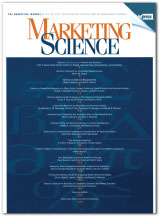Academic articles
Practitioner articles
Working papers
Books
Book chapters
Case studies
Other publications
Subject(s)
Marketing
Keyword(s)
consumer choice, consideration sets, decision making
Superfluous choices are unnecessary choice steps that could be removed without affecting the final choice context and outcome. They are introduced in this article in order to study the mere effects of consumer participation. Superfluous choices have no immediate impact on the chosen option but strongly increase consumers' propensity to persist with the same option on future choice occasions. Four experiments that isolate and investigate this indirect effect and its moderatorshighlight the impact of consumer participation that derives from a perception of greater deliberation and fluency in decision making.
With permission of the University of Chicago Press
Volume
33
Journal Pages
454–460
Subject(s)
Marketing
Keyword(s)
business markets, consumer behavior, economic theory, rationality, rational behavior, rational choice
Volume
1
Journal Pages
79–99
Subject(s)
Economics, politics and business environment
Volume
4
Journal Pages
30–32
Subject(s)
Human resources management/organizational behavior
Keyword(s)
careers, economic development, political economy, Russia
Purpose - The purpose of this article is to raise awareness of the dynamic character of career and its key attributes, and the embeddedness of their definitions and meanings in national social, political and economic contexts. Design/methodology/approach - Features of three recent distinct social, political and economic situations in Russia are used to explore the meanings of nine key career attributes introduced by the Western career literature. Findings - It was found that in Russia each of the nine key career attributes accommodates a different meaning compared with their original Western meaning, and that these meanings are continuously changing to reflect the current social, political and economic environment. In sum, this exploration revealed a dynamic character to career attributes, and their content changed depending on the underlying context. Research limitations/implications - Among key research implications are: a possibility of using Western career theories mainly as conceptual frameworks for studying careers in other countries; that current social, political and economic contexts need to be taken into consideration when studying careers in a particular country; and the 'intelligent career' concept can be used to study careers in various cultural contexts, and to examine the interdependence between career and a national culture. Originality/value - This paper examines the extent to which Western career concepts may be used to study careers in various countries around the globe. It notes the dynamic character of career and its related career attitudes. This paper also makes suggestions on how the 'intelligent career' concept can be used for exploring career meanings in a particular national setting. Finally, this paper looks at specifics of careers in Russia, which are still underrepresented in the literature.
With permission of Emerald
Volume
12
Journal Pages
68–85
Subject(s)
Marketing
Keyword(s)
production differentiation, marketing strategy, consumer behavior, pricing, cost of thinking, entry decision, consumer empowerment
Consumers aware of a new benefit will often experience uncertainty about its personal relevance or usage value. This paper shows that the decision to deliberate further to resolve this uncertainty and reach a polarized judgment of personal relevance critically depends on the posted price. In particular, a price above the consumer's initial willingness to pay might be thought provoking and enhance the perception of relevance with a certain probability. This behavioral mechanism is introduced formally and by way of an experiment with reference to the purchase of organic lettuce and fair-trade coffee. Accounting for the effect of price as a stimulus to think, a monopolistic firm should either over price ("transgressive pricing") or under price ("regressive pricing") in comparison to the consumer's willingness to pay. Under certain circumstances, the firm should also empower consumers with means that reduce the effort of deliberation.
© 2007 INFORMS
Volume
26
Journal Pages
118–129
Subject(s)
Product and operations management
Keyword(s)
manufacturing strategy, supply chain, new product development, innovation
Volume
2
Journal Pages
1–20
Subject(s)
Marketing
Keyword(s)
Befragung, Virtuelle Informationsbörse, Entscheidungsproblem, Prognose, Wissen, Informationsmarkt, Informationssammlung
Volume
60
Journal Pages
321–334
Subject(s)
Economics, politics and business environment
Keyword(s)
competition policy, effects-based approach, antitrust, state aids, mergers
Volume
29
Journal Pages
281–304
Subject(s)
Economics, politics and business environment
Keyword(s)
competition policy
This paper allows for endogenous costs in the estimation of price cost margins. In particular, we estimate price-cost margins when firms bargain over wages. We extent the standard two-equation set-up (demand and first-order condition in the product market) to include a third equation, which is derived from bargaining over wages. In this way, price-cost margins are determined by wages and vice versa. We implement the model using data for eight European airlines from 1976-1994, and show that the treatment of endogenous costs has important implications for the measurement of price-cost margins and the assessment of market power. Our main result is that observed prices in Europe are virtually identical to monopoly prices, even though observed margins are consistent with Nash behavior. Apparently, costs had been inflated to the point that the European consumers were faced with a de facto monopoly prices.
© Blackwell Publishing Ltd. 2006
Volume
54
Journal Pages
351–368
Subject(s)
Strategy and general management
Keyword(s)
competitive strategy, competitive advantage, madonna, customer analysis
Looking outside the confines of the usual business sphere, we find that Madonna is a born entrepreneur.Jamie Anderson and Martin Kupp reveal the business side of an entertainment legend.
© 2006 The Author Journal compilation © 2006 London Business School
Volume
17
Journal Pages
26–31



